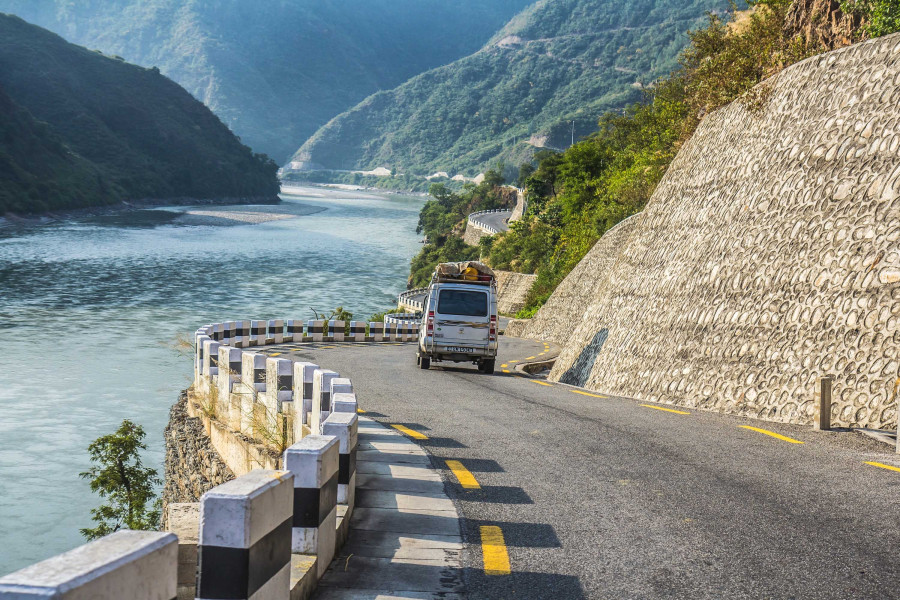Money
Chinese firm wins Rs10 billion contract to build Sunkoshi Marin diversion tunnel
The diversion tunnel will redirect part of the flow of the Sunkoshi River to irrigate farmlands in the Tarai.
Sangam Prasain
China Overseas Engineering Co won the contract for the construction of a tunnel for the Sunkoshi Marin Diversion Multipurpose Project by offering to do it for Rs10.05 billion, nearly Rs6 billion less than the price quoted by the government.
The proposed 13.3-km diversion tunnel will redirect part of the flow of the Sunkoshi River to the Bagmati River to irrigate farmlands in the Tarai. The construction site is located in Sindhuli district, about 120 km southeast of Kathmandu on BP Highway.
“We have issued a letter of intent to the lowest bidder. We are expecting to sign the contract next week,” said project chief Sushil Acharya. “Work will begin immediately after the contract is signed.” The tunnel has to be completed in 27 months, said Acharya.
According to Acharya, the Chinese company will use a tunnel boring machine to cut through the hills, which will make Sunkoshi Marin the second project after the Bheri Babai Diversion Multipurpose Project in Surkhet to do so.
The 12.2-km Bheri Babai tunnel was also constructed by China Overseas Engineering Co to irrigate 51,000 hectares of land in Banke and Bardia districts in south-western Nepal.
The Rs83.51 billion Sunkoshi Marin project located in Sindhuli and Ramechhap districts envisages taking water from the Sunkoshi River and directing it into the Bagmati River to irrigate 122,000 hectares of farmland in Rautahat, Dhanusha, Mahottari, Sarlahi and Bara districts in the southern plains.
According to project officials, the irrigation scheme is estimated to cost Rs37.3 billion and the hydropower component Rs46.19 billion. The tunnel is part of the irrigation component.
The water from the Sunkoshi will first be diverted to the Marin River in Sindhuli through the 7-metre-wide tunnel before being channelled into the Bagmati River. The water will then be collected at a barrage and distributed to irrigate fields.
Low water flows in the Bagmati River have caused severe difficulties for farmers in Rautahat and Sarlahi districts to irrigate their fields. In the dry season, irrigation facilities are not available.
The project proposes to construct a 12-metre high barrage across the Sunkoshi River and divert a discharge of 67 cubic metres per second through the tunnel to Kusumtar located in Ward 6 of Kamalamai Municipality. A powerhouse will be built on the Marin River to generate 28.62 megawatts of electricity.
The installed capacity of the hydropower project was initially set at 42.3 megawatts. During the feasibility study, planners decided that a 28.62 megawatt project would be most economical and viable.
The Sunkoshi Marin Diversion Multipurpose Project intends to provide round-the-year irrigation facility to five drought-prone districts in the southern plains, decades after it was envisioned.
The project was first mooted in 2016 when the government had planned to launch a scheme entitled Prosperous Tarai-Madhes Irrigation Special Programme to provide water to parched farmlands in five drought-prone Tarai districts.
At that time, the Ministry of Irrigation had proposed to develop the Sunkoshi Marin Diversion Multipurpose Project to provide irrigation facilities to these districts.
Insufficient rainfall has long been a recurrent problem here. A massive outflow of youths to foreign lands, creating a shortage of labourers to carry out agricultural activities, made things more difficult for local farmers.
According to Acharya, the project is crucial to boost the country’s farm output.
The proposed multipurpose project will inundate 312 hectares of land and create a pond in Sunkoshi and Khadadevi rural municipalities and Manthali municipality affecting 3,026 households, as per a draft of the environmental impact assessment.
The scheme will also submerge a 1-km stretch of Banepa-Bardibas Highway (BP Highway) and a 475-metre stretch of the road will have to be relocated to accommodate water intake and other structures.
According to the environmental impact assessment of the Sunkoshi Marin Diversion Multipurpose Project, year-round irrigation facilities will be a boon to farmers and help to boost production in the present context when the country is facing a food deficit and has to import food grain.
Nepal’s paddy production reached a record high for the fourth straight year due to good monsoon rains and an abundant supply of farmhands this fiscal year, even though a severe shortage of chemical fertiliser during transplantation and top dressing caused distress among farmers.
According to the Ministry of Agriculture and Livestock Development, farmers harvested 5.62 million tonnes of paddy, up by a marginal 1.28 percent compared to last year.
This year, there was plentiful rain and an ample labour supply as virus lockdowns sent back hordes of migrant workers to their villages which helped South Asian countries gather bumper harvests.
Province 2 saw its paddy output increase by 0.87 percent to 1.43 million tonnes, the highest among all provinces, due to abundant rainfall. Paddy is planted on 382,275 hectares in Province 2.
The hydropower component is the secondary benefit of the project. Though the cost per megawatt is estimated to be Rs1.61 billion, which is overly high, the overall project is economically viable with an economic internal rate of return of 17.04 percent, as per the detailed feasibility study.




 15.12°C Kathmandu
15.12°C Kathmandu















